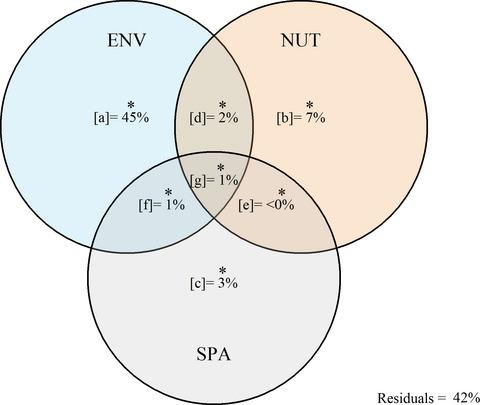当前位置:
X-MOL 学术
›
Austral Ecol.
›
论文详情
Our official English website, www.x-mol.net, welcomes your
feedback! (Note: you will need to create a separate account there.)
Environmental conditions are more effective than nutrient availability and spatial processes on explaining microphytoplankton functional structure in a subtropical hypereutrophic reservoir
Austral Ecology ( IF 1.6 ) Pub Date : 2021-09-14 , DOI: 10.1111/aec.13110 Jonatas Alves 1 , Lorena Pinheiro‐Silva 1 , Karling Fernanda Schuster 2 , Alexandre Matthiensen 3 , Mauricio Mello Petrucio 1
Austral Ecology ( IF 1.6 ) Pub Date : 2021-09-14 , DOI: 10.1111/aec.13110 Jonatas Alves 1 , Lorena Pinheiro‐Silva 1 , Karling Fernanda Schuster 2 , Alexandre Matthiensen 3 , Mauricio Mello Petrucio 1
Affiliation

|
The structure of freshwater phytoplankton communities can be strongly influenced by environmental and spatial processes at different scales. To identify the main forces that drive phytoplankton structure becomes a relevant tool to understand several knowledge gaps in the phytoplankton ecology domain, such as community succession, biological invasions and responses to disturbances. We used the morphological-based functional groups (MBFG) approach to investigate the influence of environmental conditions (physical and chemical factors), nutrient availability and spatial processes (habitat connection and species dispersal) in structuring microphytoplankton community in a subtropical hypereutrophic reservoir located in southern Brazil. Samples were taken quarterly, between February 2017 and December 2018. We used distance-based multivariate analysis of variance (PERMANOVA) to evaluate potential spatial and seasonal dissimilarities in the MBFG’s biovolume, and variation partitioning approach (pRDA) to evaluate the role of environmental, nutrient availability and spatial components in explain the microphytoplankton community structure. We identified 16 microphytoplankton taxa, which were sorted into five MBFGs. Significant seasonal dissimilarities were observed in the MBFG’s biovolume. Higher relative biovolume of potential harmful cyanobacteria (MBFG III) and alien dinoflagellates (MBFG V) was observed in summer and autumn/winter, respectively. Pure environmental component (composed by physical and chemical predictors insolation, precipitation, total dissolved solids, turbidity, water temperature, water transparency and wind intensity) explained 45% of the variance in the MBFG’s biovolume, whereas pure nutrient availability component explained 7% and spatial component explained only 3% of the biotic variance. The results showed that the environmental factors – especially the seasonal-influenced ones – are more effective than nutrient availability and spatial processes in explaining the microphytoplankton community structure in this ecosystem. Our findings alert to the need to consider the variability of the environmental conditions (mainly those directly influenced by seasonality) in phytoplankton community structure in disturbed freshwater ecosystems prone to eutrophication events.
中文翻译:

在解释亚热带超富营养水库中的微型浮游植物功能结构方面,环境条件比养分有效性和空间过程更有效
淡水浮游植物群落的结构会受到不同尺度的环境和空间过程的强烈影响。确定驱动浮游植物结构的主要力量成为了解浮游植物生态学领域中若干知识空白的相关工具,例如群落演替、生物入侵和对干扰的响应。我们使用基于形态的功能组 (MBFG) 方法来研究环境条件(物理和化学因素)、养分有效性和空间过程(栖息地连接和物种扩散)对构建位于南部亚热带富营养化水库中的微型浮游植物群落的影响。巴西。样本在 2017 年 2 月至 2018 年 12 月期间每季度采集一次。我们使用基于距离的多元方差分析 (PERMANOVA) 来评估 MBFG 生物体积中潜在的空间和季节差异,并使用变异分区方法 (pRDA) 来评估环境、养分可用性和空间成分在解释微型浮游植物群落结构中的作用。我们确定了 16 个微型浮游植物分类群,它们被分类为五个 MBFG。在 MBFG 的生物量中观察到显着的季节性差异。在夏季和秋季/冬季,分别观察到潜在有害蓝藻 (MBFG III) 和外来甲藻 (MBFG V) 的相对生物量较高。纯环境成分(由日照、降水、总溶解固体、浊度、水温、水透明度和风强度)解释了 MBFG 生物体积变化的 45%,而纯养分有效性成分解释了 7%,而空间成分仅解释了生物变化的 3%。结果表明,在解释该生态系统中的微型浮游植物群落结构时,环境因素——尤其是受季节影响的因素——比养分有效性和空间过程更有效。我们的研究结果提醒需要考虑容易发生富营养化事件的受干扰淡水生态系统中浮游植物群落结构中环境条件(主要是受季节性直接影响的环境条件)的可变性。而纯养分可利用成分解释了 7%,而空间成分仅解释了 3% 的生物变异。结果表明,在解释该生态系统中的微型浮游植物群落结构时,环境因素——尤其是受季节影响的因素——比养分有效性和空间过程更有效。我们的研究结果提醒需要考虑容易发生富营养化事件的受干扰淡水生态系统中浮游植物群落结构中环境条件(主要是受季节性直接影响的环境条件)的可变性。而纯养分可利用成分解释了 7%,而空间成分仅解释了 3% 的生物变异。结果表明,在解释该生态系统中的微型浮游植物群落结构时,环境因素——尤其是受季节影响的因素——比养分有效性和空间过程更有效。我们的研究结果提醒需要考虑容易发生富营养化事件的受干扰淡水生态系统中浮游植物群落结构中环境条件(主要是受季节性直接影响的环境条件)的可变性。
更新日期:2021-09-14
中文翻译:

在解释亚热带超富营养水库中的微型浮游植物功能结构方面,环境条件比养分有效性和空间过程更有效
淡水浮游植物群落的结构会受到不同尺度的环境和空间过程的强烈影响。确定驱动浮游植物结构的主要力量成为了解浮游植物生态学领域中若干知识空白的相关工具,例如群落演替、生物入侵和对干扰的响应。我们使用基于形态的功能组 (MBFG) 方法来研究环境条件(物理和化学因素)、养分有效性和空间过程(栖息地连接和物种扩散)对构建位于南部亚热带富营养化水库中的微型浮游植物群落的影响。巴西。样本在 2017 年 2 月至 2018 年 12 月期间每季度采集一次。我们使用基于距离的多元方差分析 (PERMANOVA) 来评估 MBFG 生物体积中潜在的空间和季节差异,并使用变异分区方法 (pRDA) 来评估环境、养分可用性和空间成分在解释微型浮游植物群落结构中的作用。我们确定了 16 个微型浮游植物分类群,它们被分类为五个 MBFG。在 MBFG 的生物量中观察到显着的季节性差异。在夏季和秋季/冬季,分别观察到潜在有害蓝藻 (MBFG III) 和外来甲藻 (MBFG V) 的相对生物量较高。纯环境成分(由日照、降水、总溶解固体、浊度、水温、水透明度和风强度)解释了 MBFG 生物体积变化的 45%,而纯养分有效性成分解释了 7%,而空间成分仅解释了生物变化的 3%。结果表明,在解释该生态系统中的微型浮游植物群落结构时,环境因素——尤其是受季节影响的因素——比养分有效性和空间过程更有效。我们的研究结果提醒需要考虑容易发生富营养化事件的受干扰淡水生态系统中浮游植物群落结构中环境条件(主要是受季节性直接影响的环境条件)的可变性。而纯养分可利用成分解释了 7%,而空间成分仅解释了 3% 的生物变异。结果表明,在解释该生态系统中的微型浮游植物群落结构时,环境因素——尤其是受季节影响的因素——比养分有效性和空间过程更有效。我们的研究结果提醒需要考虑容易发生富营养化事件的受干扰淡水生态系统中浮游植物群落结构中环境条件(主要是受季节性直接影响的环境条件)的可变性。而纯养分可利用成分解释了 7%,而空间成分仅解释了 3% 的生物变异。结果表明,在解释该生态系统中的微型浮游植物群落结构时,环境因素——尤其是受季节影响的因素——比养分有效性和空间过程更有效。我们的研究结果提醒需要考虑容易发生富营养化事件的受干扰淡水生态系统中浮游植物群落结构中环境条件(主要是受季节性直接影响的环境条件)的可变性。











































 京公网安备 11010802027423号
京公网安备 11010802027423号